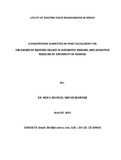| dc.contributor.author | Muriuki, Ndii K. | |
| dc.date.accessioned | 2013-10-28T06:35:09Z | |
| dc.date.available | 2013-10-28T06:35:09Z | |
| dc.date.issued | 2013-08 | |
| dc.identifier.citation | Ndii K. Muriuki (2013). Utility Of Routine Chest Radiographs In Kenya. A Dissertation Submitted In Part Fulfillment For The Award Of Masters Degree In Diagnostic Imaging And Radiation Medicine Of University Of Nairobi. | en |
| dc.identifier.uri | http://erepository.uonbi.ac.ke:8080/xmlui/handle/11295/57936 | |
| dc.description.abstract | Background
Many otherwise healthy Kenyans are required to obtain chest radiographs as part of routine
medical examination. The main reason is exclusion of Pulmonary TB , a condition of significant public health concern . Many of these people are
required to have these radiographs taken yearly as part of routine check-up. All this is
happening without any data locally to support this practice.
Though a quick procedure to perform and readily available throughout the country, a chest
radiograph exposes the individual to a dose of ionizing radiation. Ionizing radiation is
associated with increased risk of malignancy. The cost is also substantial.
Objective
The main objective of this study was to determine the prevalence of abnormal radiological
findings among routine medical examination chest radiographs.
The specific objectives were:
1. To determine the spectrum of radiological findings in routine chest radiographs with
special interest to those suggestive of PTB.
2. To find out if there is any difference in the prevalence of abnormal chest radiological
findings between males and females.
3. To determine if any difference exists in the prevalence of abnormal chest findings
between the various age groups.
4. To establish the reasons (indications) for routine chest radiographs in Kenya and their
frequencies.
Methodology
A cross-sectional study performed from October 2011 to March 2012. Chest radiographs
performed and reported during this time were analyzed. Data was collected from the
Nairobi Hospital and Plaza Imaging Solutions.
Results
A total of 402 radiographs were analyzed. The males accounted for 51.7% while the rest
48.3% were females. Out of the 402, 63 radiographs had abnormal findings (16%). Only
one radiograph (0.25%) had radiological features of PTB. The rest were reported as normal
(84%).
Migration and travel was the commonest reason for ordering the radiographs accounting for
94%. The other reasons were periodic medical exams at 3%, pre-school at 2% and others
accounting for 1%.
The spectrum of pathological findings was diverse. It was divided into two for ease of
analysis and taking into account that the main reason routine CXR are ordered is to rule out
PTB or infection capable of human to human transmission; infective and non-infective
process. As noted above, only one chest radiograph had features suggestive of an infective
process.
Conclusion
Out of 63 abnormal CXRs, only one was suspected to be PTB. The diagnostic yield for the
intended purpose (to include/exclude PTB) is therefore extremely low.
It is recommended that routine chest radiographs as a screening tools for active pulmonary
tuberculosis need to be reconsidered due to poor diagnostic yield.
The author proposes a bigger national wide study before a policy decision can be proposed. | en |
| dc.language.iso | en | en |
| dc.publisher | University of Nairobi | en |
| dc.title | Utility Of Routine Chest Radiographs In Kenya | en |
| dc.type | Thesis | en |
| dc.description.department | a
Department of Psychiatry, University of Nairobi, ; bDepartment of Mental Health, School of Medicine,
Moi University, Eldoret, Kenya | |
| local.publisher | School of Medicine | en |

